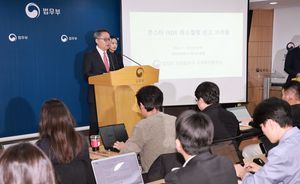![이거 한방이면 北 전력망 초토화…'정전탄' 아시나요 [이현호 기자의 밀리터리!톡]](https://contents-cdn.viewus.co.kr/image/2024/03/CP-2023-0094/image-c0d0937f-ba07-40e3-8575-3f70e6e883c0.jpeg)
In December of last year, the Ministry of National Defense announced that it would accelerate the development of various new weapons to strengthen the Korean three-axis system in response to North Korean nuclear and missile threats, as it unveiled the 2025-2028 Defense Mid-term Plan. The new weapons include ultra-small military satellites, laser weapons, hypersonic propulsion systems, suicide drones, and electromagnetic pulse bombs (EMP bombs), which are the most advanced weapon systems that have been attracting the most attention in modern warfare. Among them, the development of blackout bombs stands out. A blackout bomb, also known as a carbon fiber bomb, can incapacitate enemy power transmission networks in emergencies.
This weapon is called a blackout bomb because it hinders the enemy’s power grid and cuts off the power supply, which is essential for enemy operations.
It is also known as a carbon fiber bomb (graphite bomb) because it does not harm people, like high-flash bombs, sound weapons, and super-strong corrosives. Although there is no explosive, its power can temporarily incapacitate the functions of the enemy’s major equipment and facilities, such as vehicles and power plants. Therefore, it is classified as a non-lethal technology/weapon system (soft-kill).
The blackout bomb under development in Korea consists of two types: a boomlet-embedded bomb made by combining high-conductivity nickel and carbon fiber and a Korean GPS-guided bomb (KGGB) consisting of a guided kit for aircraft.
Called a “soft bomb” because it’s a non-lethal weapon
A blackout bomb induces power outages by causing damage to the insulation of the power system, such as transmission facilities and power lines from power plants. This is accomplished by the explosion releasing a large amount of wire made from carbon fibers, which have low electrical resistance and conductivity properties. In particular, their functionality is removed when the carbon fibers are attached to the facilities in large quantities. Since it is impossible to supply electricity without removing all of them, it takes considerable time to recover. It is a weapon system that causes significant damage to the enemy by interfering with various activities requiring electricity until the removal work is completed.
This principle is implemented by loading it onto fighter jets or missiles and, after being dropped or launched, being guided to detonate in the airspace above a pre-entered target, such as power facilities. The bomb takes away the functionality by causing a short-circuit phenomenon due to the overload of the power network when the nickel-containing carbon fibers are released infinitely from the dispersed bomblets and caught on the transmission line. Recently, the range has been dramatically increased along with the reliability of guidance and hitting accuracy using the KGGB kit (a guided bomb equipped with a guidance kit on a conventional bomb).
Moreover, since it does not scatter harmful substances or affiliated fragments around by the explosion of explosives, it is classified as a non-lethal weapon because it does not directly affect the human body. However, there is a high possibility of causing unexpected fatal damage. The blackout may lead to the shutdown of communication and transportation systems, social chaos, and the disruption of devices directly related to human life, such as life support devices.
The blackout bombs came into the world because of an unintended happening. In 1985, the US Navy dropped chaff bombs to incapacitate enemy ground-to-air guided missile radars that threatened its aircraft. However, unexpectedly, this chaff flew to a nearby power plant and caused significant damage to power production and supply. As a result, a blackout situation occurred where about 60,000 households could not use electricity.
This became the opportunity to research and develop carbon fiber bombs actively. In March 1991, the US Department of Defense approved a plan to build technology that could blackout the enemy’s main facilities as a non-lethal technology for establishing national security strategies and, at the same time, launched a research group on non-lethal warfare.
In the Gulf War in 1991, the US Navy paralyzed related facilities so that electricity could not be supplied in Baghdad. It was the first case of incapacitating not only electricity but also communication facilities by attacking Iraqi substations with Tomahawk missiles equipped with carbon fiber warheads.
In May 1999, during the Kosovo-Serbia conflict in Europe, the F-117A stealth bomber dropped the carbon fiber bomb CBU-94/B. It demonstrated its power by cutting off electricity supply in 70% of the entire territory of Yugoslavia.
Carbon fibers spread like a spider web and paralyze the power grid
Military experts evaluate that it can exert formidable power to the extent that it takes more than 7 hours to recover major facilities and more than 20 hours to recover general facilities.
CBU-94/B was developed by the US Air Force and ATK (Alliant Techsystems). It consists of a dispersion warhead, a fuse, and an explosive series, with 202 embedded BLU-114/B submunitions filled with carbon fiber composites wrapped in carbon fiber with a diameter of tens of micrometers.
The carbon fiber bomb, dropped by aerial assets, releases submunitions a few kilometers above the target with a fuse. The dispersed submunitions are sprayed with a carbon fiber composite by a submunition fuse at a few hundred meters above the target point by a sensing device during the fall by the deployed parachute.
The carbon fiber composite consists of 147 coil wire-type carbon fibers, each about 4.5km long. When sprayed, they spread like a spider web, entangling each other and paralyzing the enemy power grid.
In other words, when the BLU-114s are packed into the CBU-94 cluster bomb and dropped by a bomber or fighter aircraft in a dispersed form, the CBU-94 disintegrates in the air. Subsequently, the embedded parachutes in the BLU-114/Bs unfold and approach the target, effectively turning off the functionality of power lines and electrical facilities.
![이거 한방이면 北 전력망 초토화…'정전탄' 아시나요 [이현호 기자의 밀리터리!톡]](https://contents-cdn.viewus.co.kr/image/2024/03/CP-2023-0094/image-37fd1e8e-f66e-4054-9657-c7a33ffa363a.jpeg)
The body of blackout bombs to be developed in Korea is known to use cluster bombs like the CBU-94/B blackout bomb held by the US Air Force. The plan is known to increase the range and attack angle significantly by applying a guided kit with wings like the smart bomb KGGB developed in Korea.
If you look at the computer-generated image Poongsan revealed three years ago; it is a standoff weapon that can attack enemies from a distance because the range is extended. It features two folded wings on the top and at least five swept rectangular fins on the tail part. Poongsan’s Defense Technology Research Institute is known to have secured research and development achievements and technology through research and testing on the application of blackout bombs led by the Agency for Defense Development.
The Ministry of National Defense has set a timetable to complete the development and deployment of blackout bombs that can cause a blackout of major enemy facilities within five years at the latest. The plan is to deploy hundreds of carbon fiber bombs to the Air Force by 2028 the latest.










Most Commented